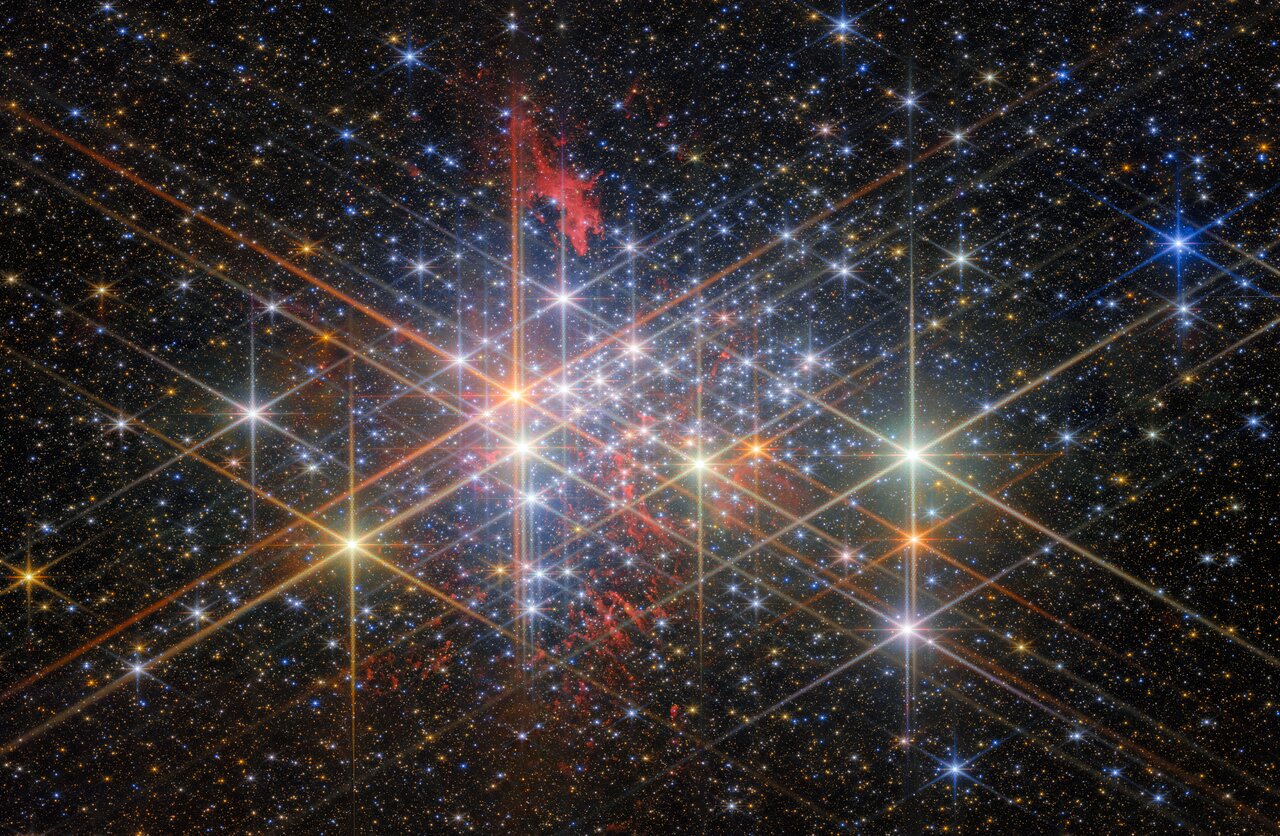
Westerlund 1 is a massive and relatively nearby young star cluster, renowned for its exotic stellar population. Situated in the constellation Ara, it lies about 12,000 light-years from Earth and is heavily obscured by interstellar dust. Its estimated age is around 3-5 million years, making it an exceptional laboratory for studying the evolution of massive stars. Here’s an overview of its exotic stellar population:
Location
Westerlund 1 is located in the southern constellation Ara. Its precise coordinates in the sky are:
- Right Ascension (RA): 16h 47m 04s
- Declination (Dec): -45° 50′ 42″
It lies approximately 12,000 light-years from Earth, placing it in the Milky Way galaxy, specifically within the Scutum-Centaurus arm.
Structure
The structure of Westerlund 1, as a massive young star cluster, is characterized by its dense population of massive stars and complex internal dynamics. Here’s an overview of its structure:
Cluster Core
- Dense Stellar Population:
- The core of Westerlund 1 is packed with a high concentration of massive stars, including supergiants, Wolf-Rayet stars, and luminous blue variables.
- Stars in the core are tightly gravitationally bound, with distances between individual stars often as small as 0.1 parsecs.
- Massive Binaries:
- A significant fraction of the stars in the core are binary systems, influencing mass transfer and dynamical interactions.
- Neutron Star:
- A neutron star located in the cluster core provides evidence of past supernova activity.
Outer Regions
- Less Dense:
- The outer regions are less dense compared to the core but still host a significant number of massive stars.
- Stellar Ejections:
- Dynamical interactions in the core can eject stars into the outer regions, leading to a spread of the cluster’s population.
Cluster Mass
- Total Mass:
- Estimated at around 50,000 solar masses, making it one of the most massive young clusters in the Milky Way.
- Dominated by Massive Stars:
- The mass distribution skews heavily toward massive stars, which dominate the cluster’s luminosity and influence its evolution.
Gas and Dust
- Minimal Residual Gas:
- Due to the intense radiation and stellar winds from its massive stars, most of the gas from the original star-forming cloud has been expelled.
- Nebular Emission:
- Some surrounding gas may still exhibit nebular emission, ionized by the intense ultraviolet radiation of the stars.
Dynamics
- Gravitational Binding:
- Westerlund 1 is thought to be gravitationally bound, which helps maintain its compact structure.
- Mass Segregation:
- More massive stars are concentrated in the core, while lower-mass stars tend to migrate outward over time, a phenomenon known as mass segregation.
Evolutionary State
Evidence of past supernovae is present, including the neutron star, which indicates that the most massive stars have already ended their lives.
Young Age:
With an estimated age of 3–5 million years, Westerlund 1 is still in an early stage of evolution.
Supernova Remnants:
Importance
Westerlund 1 is of immense importance to astrophysics due to its unique characteristics and the insights it provides into various fundamental processes. Here’s why it is significant:
Study of Massive Star Evolution
- Diverse Stellar Population:
- Westerlund 1 hosts stars in nearly every evolutionary stage of massive star life, including O-type stars, red supergiants, yellow hypergiants, blue supergiants, Wolf-Rayet stars, and neutron stars.
- Rare Phases:
- It provides a rare opportunity to observe short-lived phases like the luminous blue variable (LBV) and yellow hypergiant stages.
- End-of-Life Studies:
- The presence of a neutron star is direct evidence of supernova activity, allowing scientists to study the end stages of massive star evolution.
Star Cluster Dynamics
- Massive Star Clusters:
- Westerlund 1 is one of the most massive young clusters in the Milky Way, providing insights into the formation and evolution of such clusters.
- Mass Segregation:
- The cluster showcases how massive stars concentrate in the core while lower-mass stars migrate outward, helping refine models of dynamical evolution.
Progenitors of Supernovae and Compact Objects
- Supernova Progenitors:
- Many of its stars will end their lives as supernovae, offering a laboratory to study how such explosions occur and their precursors.
- Neutron Stars and Black Holes:
- The detected neutron star within the cluster offers clues about how massive stars collapse into compact objects.
- Westerlund 1 may also harbor binary systems that could evolve into black hole binaries.
Galactic Chemical Enrichment
- Stellar Feedback:
- The massive stars in Westerlund 1 drive strong stellar winds and eject heavy elements into the interstellar medium (ISM), enriching it with metals.
- Supernova Ejecta:
- Its eventual supernovae will further contribute to the chemical evolution of the Milky Way.
Insights into Star Formation
- Cluster Formation:
- Westerlund 1 provides a case study for the formation of massive star clusters, which are thought to be the birthplaces of most stars in galaxies.
- Initial Mass Function (IMF):
- The cluster helps refine our understanding of the IMF, particularly for massive stars.
Benchmark for Theoretical Models
- Stellar Models:
- Westerlund 1’s well-documented population offers critical data to test and refine models of stellar evolution, mass loss, and binary interactions.
- Cluster Evolution:
- It serves as a benchmark for theories about the dynamical evolution of young, dense star clusters.
Connection to Galactic Structure
- Location in the Milky Way:
- Westerlund 1 is situated in the Scutum-Centaurus arm, providing insights into star formation in a major galactic spiral arm.
- Stellar Winds and Feedback:
- The cluster’s feedback impacts the surrounding ISM, influencing future star formation in its vicinity.
Role in High-Energy Astrophysics
- High-Mass X-ray Binaries:
- The cluster likely harbors high-mass X-ray binaries, important for understanding accretion and jet physics.
- Gamma-Ray Sources:
- Its population of massive stars and compact objects may contribute to gamma-ray emissions, linking it to high-energy phenomena.
Cosmological Implications
Westerlund 1 provides clues about the properties of starburst regions in more distant or less accessible environments.
Extragalactic Analogs:
Massive clusters like Westerlund 1 resemble the young star clusters observed in other galaxies, offering a local example to study phenomena that occur on galactic scales.
Starburst Regions:
Westerlund 1 provides clues about the properties of starburst regions in more distant or less accessible environments.
Visual Impact
The visual impact of Westerlund 1 is heavily influenced by its dense stellar population, obscuration by interstellar dust, and its position within the Milky Way’s galactic plane. Here’s a breakdown of its visual and observational significance:
Obscured Visibility
- Heavily Obscured by Dust:
- In the optical spectrum, Westerlund 1 is almost entirely hidden by interstellar dust, making it invisible to the naked eye or even regular optical telescopes.
- Infrared and Radio Observations:
- Observations in the infrared and radio wavelengths reveal its structure, as these wavelengths penetrate the dust, unveiling the dense stellar population.
Dense Stellar Core
- High Luminosity:
- If the obscuring dust were removed, Westerlund 1 would appear extraordinarily bright due to the combined luminosity of its massive stars.
- Clustered Appearance:
- In high-resolution images, the stars appear tightly packed, with minimal space between them, making it one of the densest stellar clusters in our galaxy.
Colorful Star Types
- Stellar Variety:
- The cluster contains a range of massive stars with distinctive colors:
- Red Supergiants appear reddish due to their cooler surface temperatures.
- Blue Supergiants and Wolf-Rayet Stars are intensely blue or white, indicative of their high temperatures.
- Yellow Hypergiants show a golden hue, standing out in infrared observations.
- The cluster contains a range of massive stars with distinctive colors:
- Dynamic Nebulae:
- Mass loss from stars creates surrounding nebulae, which would add colorful, glowing structures to the scene in the infrared or optical spectrum.
Starburst-Like Glow
- Young Cluster Glow:
- Westerlund 1 emits light and energy comparable to clusters in starburst galaxies, making it a mini starburst region within the Milky Way.
- Infrared Highlight:
- Images taken by telescopes like the Spitzer Space Telescope reveal the cluster as a glowing, dense patch against the darker galactic plane.
X-Ray and Gamma-Ray Sources
- High-Energy Output:
- The cluster is a source of strong X-rays and gamma rays due to interactions between massive stars, their winds, and remnants like neutron stars.
- Energetic Regions:
- These emissions create “invisible” visual phenomena that can be captured by specialized telescopes, further emphasizing the high-energy environment of the cluster.
Comparative Scale
- Compact but Impactful:
- Despite being relatively small in angular size from Earth’s perspective, the sheer number and brightness of its stars make Westerlund 1 a prominent feature in astrophysical studies.
- Milky Way Jewel:
- It would be one of the most visually stunning clusters in the sky if not for the obscuration by dust.
Artistic and Conceptual Representation
Rendered images and visualizations of Westerlund 1 highlight the beauty and complexity of massive star clusters, inspiring public interest in astronomy.
Visualization Tools:
Artistic renderings of Westerlund 1 often depict a glowing, dense core surrounded by dynamic nebulae, emphasizing its exotic and energetic nature.
Impact on Astronomy Outreach:
Credit
ESA/Webb, NASA & CSA, M. Zamani (ESA/Webb), M. G. Guarcello (INAF-OAPA) and the EWOCS team
